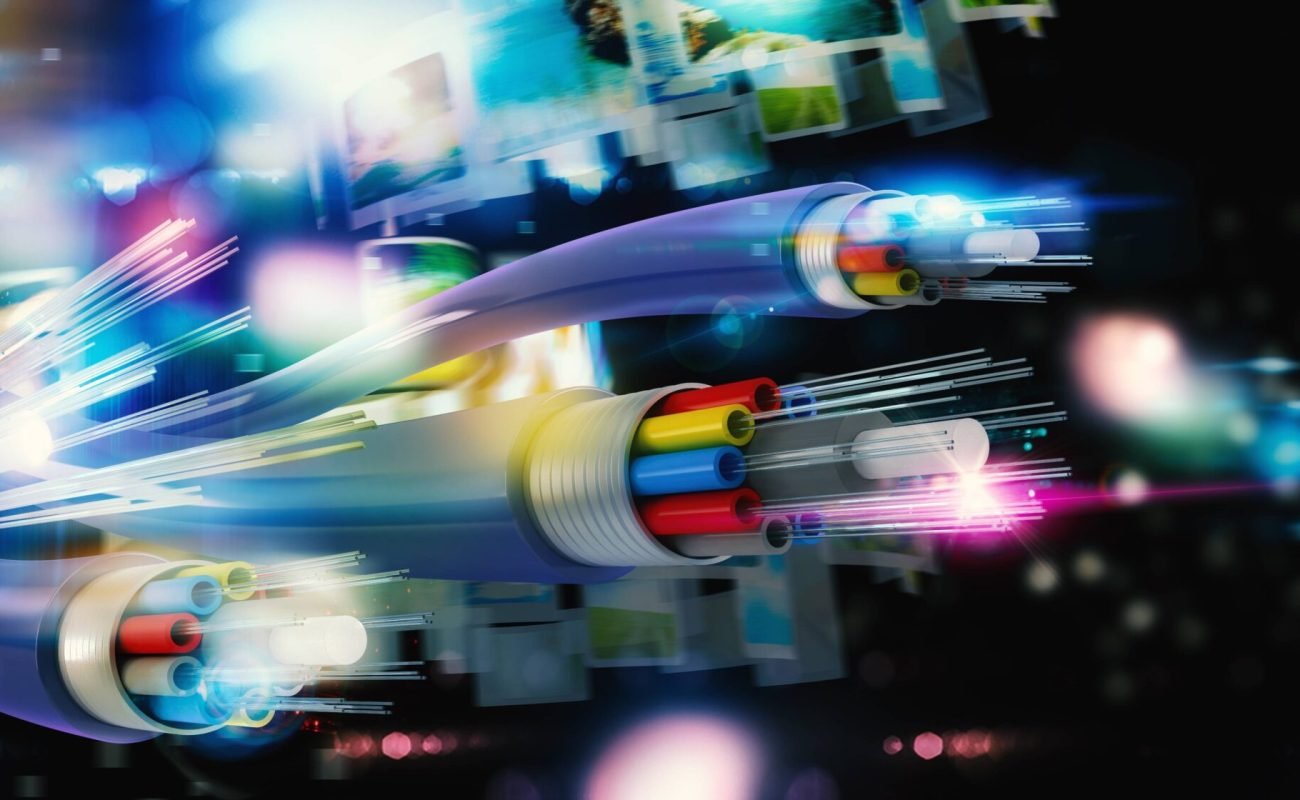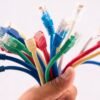Fiber optic cables have revolutionized the way we transmit data over long distances. These cables use light to transmit signals, making them faster and more efficient than traditional copper cables.
However, not all fiber optic cables are created equal. There are different types of fiber optic cables, each with strengths and weaknesses.
Understanding the differences between these cables can help you make an informed decision when choosing the suitable cable for your needs.
Single-mode fiber optic cables
Single-mode fiber is r with a small core diameter, typically around 9 microns. This fiber is designed to carry a single light wave, which allows for high bandwidth and fast data transfer rates over long distances.
The characteristics and advantages of single-mode fiber include the following:
- High Bandwidth: Single-mode fiber has a high bandwidth, which means it can transmit large amounts of data quickly and efficiently. This is important for applications such as internet service providers, telephone networks, and cable television networks.
- Long Distance: Single-mode fiber can transmit data over longer distances without degradation or loss. The small core diameter allows for less signal dispersion, making it ideal for long-distance communication.
- Immunity to Electromagnetic Interference: Single-mode fiber is immune to electromagnetic interference, making it less susceptible to signal loss or distortion. This makes it ideal for use in areas with high levels of electromagnetic interference.
- Secure Communication: Single-mode fiber is more secure than traditional copper cables since it is difficult to tap or hack. This makes it ideal for military communication systems and other applications where fast data transfer is critical.
Some of the applications of single-mode fiber include:
- Telecommunications: Single-mode fiber is commonly used in telecommunications networks, such as internet service providers and telephone networks, where high-speed and reliable data transfer is essential.
- Cable Television Networks: Single-mode fiber is also used in cable television networks to transmit high-definition video and other data.
- Scientific Research: Single-mode fiber is used in scientific research for medical imaging, astronomy, and quantum computing applications.
- Military Communication Systems: Single-mode fiber is used in military communication systems for secure and reliable data transfer.
Multi-mode fiber optic cables
Multi-mode fiber is r with a larger core diameter than single-mode fiber, typically ranging from 50 to 62.5 microns. It uses multiple light waves to transmit data, which makes it suitable for shorter distances and lower bandwidth applications.
The characteristics and advantages of multi-mode fiber include:
- Low Cost: Multi-mode fiber is less expensive than single-mode fiber, making it an ideal choice for applications with shorter distances and lower bandwidth requirements.
- Easy Installation: Multi-mode fiber is easier to install than single-mode fiber since it has a larger core diameter. It can be terminated using more straightforward and less expensive connectors.
- High Capacity: Multi-mode fiber can carry a large amount of data, making it ideal for applications such as local area networks (LANs), data centers, and CCTV systems.
- Flexibility: Multi-mode fiber can be used in various applications due to its flexibility and versatility.
Some of the applications of multi-mode fiber include:
- Local Area Networks: Multi-mode fiber is commonly used in LANs, where it is used to connect computers and other network devices.
- Data Centers: Multi-mode fiber connects servers, storage systems, and other network devices.
- CCTV Systems: Multi-mode fiber is used in CCTV systems to transmit video data over short distances.
- Audio and Video Applications: Multi-mode fiber is used in audio and video applications, such as home theaters and video conferencing systems.
Sợi quang nhựa
The plastic optical fiber (POF) is a type of optical fiber that uses plastic fibers to transmit light signals. POF has a larger core diameter than traditional glass fiber optic cables, typically ranging from 0.5 to 2 millimeters.
The characteristics and advantages of plastic optical fibers include the following:
- Cost-effective: POF is less expensive than traditional glass fiber optic cables, making it a more cost-effective option for specific applications.
- Easy to Install: POF is easy to install and terminate using simple connectors, making it a popular choice for home networking and industrial applications.
- Flexible: POF can be bent without breaking, making it ideal for installations in tight spaces.
- Electrical Insulation: POF is an electrical insulator that is not susceptible to electromagnetic interference.
Some of the applications of plastic optical fibers include:
- Automotive: POF is used in automotive data transfer and lighting systems applications.
- Industrial: POF is used in industrial automation and control systems due to its cost-effectiveness and easy installation.
- Home Networking: POF is used in home networking applications for high-speed internet and data transfer.
- Gaming Consoles: POF connects peripherals such as controllers and headsets.
- Medical Equipment: POF is used for imaging and diagnostic applications.
Loose Tube Fiber Optic Cable
Loose tube optical fiber is designed to withstand harsh environments and outdoor installations. It consists of central tube ple fiber optic strands protected by a layer of gel or water-resistant material.
The characteristics and advantages of loose tube optical fibers include the following:
- Resistance to Environmental Factors: Loose tube optical fibers resist moisture, temperature fluctuations, and physical damage, making them ideal for outdoor installations and harsh environments.
- High Reliability: Loose tube optical fibers are designed to maintain signal integrity even under extreme conditions, ensuring high reliability in data transfer.
- High Flexibility: Loose tube optical fibers can be installed in tight spaces and difficult-to-access areas.
- High Capacity: Loose tube optical fibers have a high capacity and can carry a large amount of data, making them ideal for applications that require high bandwidth.
Some of the applications of loose tube optical fibers include:
- Military Communication Systems: Loose tube optical fibers are used in military communication systems for secure and reliable data transfer in harsh environments.
- Oil and Gas Exploration: Loose tube optical fibers are used in oil and gas exploration and monitor drilling operations.
- Marine Communication Systems: Loose tube optical fibers are used in marine communication systems for data transfer and navigation.
- Traffic Management Systems: Loose tube optical fibers are used in traffic management systems for real-time data transfer and monitoring.
Ribbon Fiber Optic Cable
A ribbon fiber optic cable is a type of fiber optic cable that consists of multiple fibers bonded together in a flat ribbon-like structure. These fibers are typically arranged in a parallel configuration and are encapsulated within a protective outer sheath. This response will discuss the characteristics and advantages of ribbon fiber optic cables and some of their typical applications.
Characteristics of Ribbon Fiber Optic Cables:
- High Fiber Density: Ribbon fiber optic cables can contain many individuals. Fibers within an l cross-sectional are ideal for uses requiring high fiber density.
- Compact Design: The flat ribbon-like structure of these cables allows them to be easily stacked and routed within small spaces, which is beneficial in tight or crowded installations.
- High Bandwidth: Ribbon fiber optic cables are capable of transmitting large amounts of data at high speeds, which makes them suitable for high-bandwidth applications such as data centers, telecommunications, and video transmission.
- Easy Installation: The flat ribbon-like structure of these cables allows for quick and easy installation, saving time and labor costs.
Advantages of Ribbon Fiber Optic Cables:
- Space-Saving: The compact design of ribbon fiber optic cables makes them ideal for use in installations where space is limited or multiple wires must be installed nearby.
- Cost-Effective: Ribbon fiber optic cables can be more cost-effective than individual fiber cables when many fibers need to be installed in a single location.
- Easy Identification: The flat ribbon-like structure of these cables allows for easy fiber identification and separation, simplifying installation and maintenance.
- High Performance: Ribbon fiber optic cables are designed to provide high performance, reliability, and durability, which makes them ideal for use in critical applications.
Applications of Ribbon Fiber Optic Cables:
- Data Centers: Ribbon fiber optic cables are commonly used to provide high-bandwidth connectivity between servers and other network equipment.
- Telecommunications: Ribbon fiber optic cables are used in telecommunications applications to provide high-speed data transmission over long distances.
- CATV: Ribbon fiber optic cables are used in cable television (CATV) systems to transmit video and data signals from a central location to multiple remote locations.
- Industrial Automation: Ribbon fiber optic cables are used in industrial automation applications to transmit high-speed data between sensors, controllers, and other equipment.
- Military: Ribbon fiber optic cables are used in military applications to provide secure, high-bandwidth communications in harsh and rugged environments.
Armored Fiber Optic Cable
An armored fiber optic cable is a type of fiber optic cable that is designed with an additional protective layer to provide enhanced durability and protection against mechanical damage. This layer is typically made from solid steel, aluminum, and rial wrapped around the cable’s outer sheath. In this response, we’ll talk about the characteristics and advantages of armored fiber optic cables and some of their typical applications.
Characteristics of Armored Fiber Optic Cables:
- High Mechanical Strength: Armored fiber optic cables are designed to provide enhanced protection against mechanical damage, such as crushing, bending, or cutting.
- Increased Durability: The additional protective layer of armored fiber optic cables makes them more resistant to environmental factors such as moisture, temperature fluctuations, and UV radiation.
- Wide Temperature Range: Armored fiber optic cables can operate within a wide range, making them suitable for use in harsh environments.
- Corrosion Resistance: The protective layer of armored fiber optic cables provides a barrier against corrosion, which extends the cable’s lifespan.
Advantages of Armored Fiber Optic Cables:
- Enhanced Protection: Armored fiber optic cables offer improved protection against physical damage, which makes them ideal for use in applications where lines may be exposed to harsh environmental conditions or where they may be at risk of accidental injury.
- Improved Reliability: The added protection of armored fiber optic cables can increase their reliability and reduce the need for frequent maintenance or repairs.
- Cost-Effective: Although armored fiber optic cables may be more expensive than non-armored cables, they can provide cost savings in the long run by reducing the need for replacement or repair due to damage.
- Versatility: Armored fiber optic cables can be used in various applications, including indoor and outdoor installations, aerial installations, and direct burial.
Applications of Armored Fiber Optic Cables:
- Military and Defense: Armored fiber optic cables are commonly used in military and defense applications to provide secure, reliable communications in harsh and rugged environments.
- Industrial Automation: Armored fiber optic cables are used in industrial automation applications to provide high-speed data transmission between sensors, controllers, and other equipment in harsh environments.
- Oil and Gas: Armored fiber optic cables are used in oil and gas applications to provide reliable and secure communication in harsh environments such as offshore rigs and pipelines.
- Mining: Armored fiber optic cables are used in mining applications to provide reliable communication and data transmission in harsh and hazardous environments.
- Telecommunications: Armored fiber optic cables are used in telecommunications applications to provide high-speed data transmission over long distances in environments where the wires may be at risk of accidental damage.
Composite Fiber Optic Cable
A composite fiber optic cable is a type of fiber optic cable that consists of multiple layers of different materials. These layers may include fiber optic strands, strength members, water-blocking materials, and protective jackets. Composite fiber optic cables are designed for durability, making them ideal for various applications. In this response, we will discuss the characteristics and advantages of composite fiber optic cables and some of their typical applications.
Characteristics of Composite Fiber Optic Cables:
- High Strength: Composite fiber optic cables are designed to enhance strength and durability, making them resistant to physical damage such as crushing, bending, or cutting.
- Water Resistance: Composite fiber optic cables may include water-blocking materials to protect against moisture and water damage, which can extend the cable’s lifespan.
- Wide Temperature Range: Composite fiber optic cables can operate within a wide temperature range, making them suitable for use in harsh environments.
- Corrosion Resistance: Composite fiber optic cables may include protective jackets or coatings to provide a barrier against corrosion.
Advantages of Composite Fiber Optic Cables:
- Enhanced Performance: Composite fiber optic cables are designed to provide improved performance in speed, bandwidth, and reliability, making them ideal for use in high-demand applications.
- Versatility: Composite fiber optic cables can be designed to meet specific performance requirements and used in various applications, including indoor and outdoor installations, aerial installations, and direct burial.
- Cost-Effective: Although composite fiber optic cables may be more expensive than non-composite cables, they can provide cost savings in the long run by reducing the need for replacement or repair due to damage.
- Improved Reliability: The added layers of protection and durability of composite fiber optic cables can increase their reliability and reduce the need for frequent maintenance or repairs.
Applications of Composite Fiber Optic Cables:
- Telecommunications: Composite fiber optic cables are commonly used in telecommunications applications to transmit high-speed data over long distances.
- Oil and Gas: Composite fiber optic cables are used in oil and gas applications to provide reliable and secure communication in harsh environments such as offshore rigs and pipelines.
- Mining: Composite fiber optic cables are used in mining applications to provide reliable communication and data transmission in harsh and hazardous environments.
- Military and Defense: Composite fiber optic cables are commonly used in military and defense applications to provide secure, reliable communications in harsh and rugged environments.
- Industrial Automation: Composite fiber optic cables are used in industrial automation applications to provide high-speed data transmission between sensors, controllers, and other equipment in harsh environments.
Comparison of fiber optic cables
When choosing a fiber optic cable, several types of lines must be considered. Each type of cable has its unique characteristics, advantages, and applications. In this response, we will compare the following types of fiber optic cables: single-mode, multi-mode, plastic optical fiber, loose tube, ribbon, armored, and composite. We will also discuss the factors to consider when choosing a fiber optic cable.
- Single-Mode Fiber Optic Cable: Single-mode fiber optic cables have a small core diameter and are designed for use with light sources. They provide high bandwidth over long distances and are ideal for plications, such as telecommunications and internet service providers.
- Multi-Mode Fiber Optic Cable: Multi-mode fiber optic cables have a larger core diameter than single-mode cables and can support multiple wavelengths of light. They are suitable for use in applications ta transmission distances, such as within a building or on campus.
- Sợi quang nhựa: Optical fiber is a low-cost alternative to glass fiber optic cables. They have a larger core diameter than glass fiber optic cables. They are suitable for use in in-home networking and automotive applications.
- Loose Tube Fiber Optic Cable: Loose tube fiber optic cables comprise individual fiber strands surrounded by a protective outer sheath. They are designed for outdoor installations and can withstand harsh environmental conditions such as temperature fluctuations, moisture, and UV radiation.
- Ribbon Fiber Optic Cable: Ribbon fiber optic cables are designed with multiple fiber strands bonded together in a flat ribbon-like structure. They are ideal for use in high fiber-density applications, such as in data centers and telecommunications.
- Armored Fiber Optic Cable: Armored fiber optic cables have an additional protective layer to enhance durability and protection against mechanical damage. They are suitable for use in applications where lines may be exposed to harsh environmental conditions or where they may be at risk of accidental injury.
- Composite Fiber Optic Cable: Composite fiber optic cables consist of multiple layers of different materials, including fiber optic strands, strength members, water-blocking fabrics, and protective jackets. They are designed for durability, making them ideal for various applications.
Factors to Consider When Choosing a Fiber Optic Cable:
- Distance: The distance over which data needs to be transmitted will determine the type of fiber optic cable required.
- Băng thông: The required bandwidth will determine the type of fiber optic cable required.
- Environmental Conditions: The conditions in which the cable will be installed will determine the type of cable required.
- Installation Method: The installation method, such as aerial or underground, will determine the type of cable required.
- Cost: The cable and associated equipment will factor in the decision-making process.
- độ tin cậy: The reliability of the cable and associated equipment will be a factor in the decision-making process.
Phần kết luận
Fiber optic cables have multiple types, each with its benefits. They are critical for modern communication and data transfer, providing high bandwidth, long transmission distances, and low signal loss. Selecting the appropriate cable is essential for project success.
As technology develops, fiber optic cables will remain vital. I’d like you to look for expert advice to ensure you can fulfill your needs.










